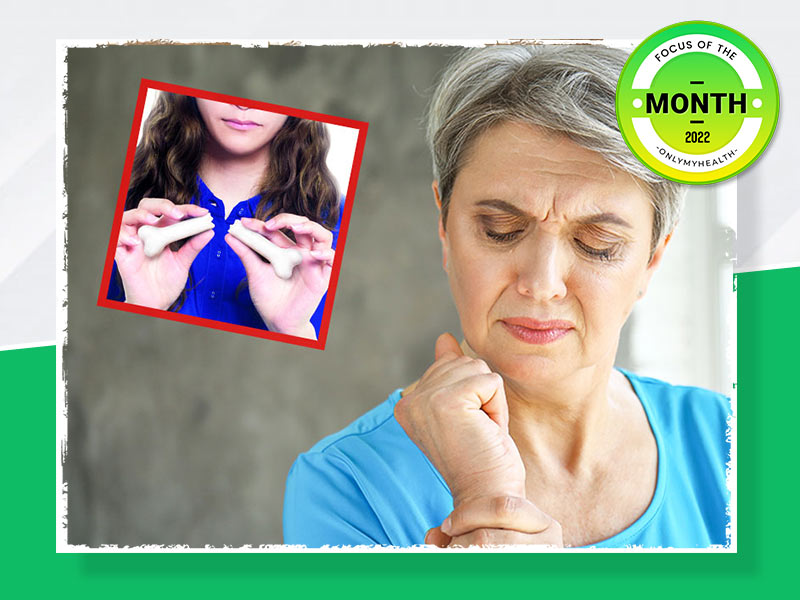
Bone health and related conditions can affect you at any stage of life. But they become more prominent in the later stages, especially in women. Osteoporosis is a condition of gradual weakening of the bones. According to a study by Indian Society of Bone and Mineral Research (ISBMR), estimates from 2015 suggest that 20% of the 230 million Indian women over age 50 have osteoporosis. To raise awareness about these lesser-known health topics, we are conducting an ongoing campaign called “Healthy Living” where we try to focus on health aspects of every individual. Today our focus would be on osteoporosis in women after they reach menopause.
Table of Content:-
Osteoporosis in Women: What Should You Know?
We consulted Dr. Nilen Shah, Consultant Orthopaedics, P D Hinduja Hospital & Medical Research Centre, Khar to help us understand about condition of osteoporosis in women after menopause. He explained, in women, osteoporosis is more common in two types, post-menopausal osteoporosis and senile. Estrogen and progesterone, the female sex hormones have a positive effect on the bony skeleton by promoting the activity of osteoblasts. These are cells that make new bone and regulate bone metabolism. At menopause, the level of estrogen and progesterone hormones decreases in the body.

These hormonal changes and decreased circulation of the estrogen hormones in the body, result in deleterious effect by negatively impacting the bone strength. Many studies have reported the prevalence of osteoporosis ranging from 8 to 62% in Indian women of different age groups. In general, peak bone mass (strength) is achieved by the age of 25 years, after which there is a gradual decline in bone density and strength.
How Does Osteoporosis develop Post Menopause?
As the effect of the estrogen wanes, osteoporosis develops. The main cause of osteoporosis remains majorly the same for all women. But due to hormonal changes taking place during menopause effect women in such a way that it increases the risk of osteoporosis in them.
Also, post-menopause, women who are taking hormone replacement therapy have decreased incidence of osteoporosis compared to others. Whether hormone replacement therapy should be taken or not is a decision that should be made not just on basis manifestation of osteoporosis but also on other factors. Other factors can include age, family and personal medical history. This is usually a joint decision that should be taken in consultation with a physician and gynecologist.
Also Read- Do You Know Why A Kidney Fails? Here Are The Causes, Symptoms and Treatment Options
Symptoms of Osteoporosis After Menopause
On the whole, osteoporosis is considered a silent disease as no major symptoms are observed. This is until the bone strength decreases drastically and causes a fracture. Postmenopausal women can experience symptoms such as the following-
- Discomfort in walking
- Lower body pain
- Joint aches
- Difficulty in standing up from low benches
If there is a deficiency of Vitamin D in this condition, it is called osteomalacia. People may experience aches and pains in the body. However, osteoporosis may go undetected till specialized tests are conducted.

Difference Between Osteoporosis and Osteoarthritis in Women
- Osteoarthritis affects the joints where two bones connect, while osteoporosis affects the bone density.
- Osteoporosis affects the bone composition, while osteoarthritis affects the exterior of the bones where a joint is formed.
- Osteoarthritis is caused due to older age, joint injuries, and obesity while osteoporosis may result due to various factors such as hormonal changes, reaction of oral drugs and other treatments used in conditions such as epilepsy.
Also Read- Is Infertility Genetic? Know About Genetic Causes of Infertility in Men and Women
Precautionary Measures for Women After Menopause
After crossing the age of 55-60 years, all women are advised to take precautionary tests like estimation of bone chemistry, calcium, vitamin and DEXA bone scan to establish or rule out osteoporosis.
Any female suffering with osteoporosis should avoid any activity or physical risk where a fracture may occur. If a person observes difficulty in balancing, or if they are already suffering from osteoporosis and osteoarthritis, usage of walking aids is advised.
Most instances of fractures especially in elderly occur due to physical falls during day-to-day activities. Hence, some basic measures such as installing grab bars and hand rails, avoid wearing loose clothes, wearing shoes, removing tripping hazards.

As osteoporosis implies weakening of bones, the most basic and effective solution is to include focused exercises such as walking, low-impact aerobics, climbing stairs and weight-bearing routines in your routine life.
Include calcium and vitamin D supplements. You can also consider options such as hormone replacement therapy, or selective estrogen receptor modulators, and anti-resorptive agents, of which alendronate is a fairly popular oral tablet are also some ways of managing this condition.
Conclusion
It goes without saying that prevention is better than cure. This holds true value in case of osteoporosis for women as well. Women especially above the age of 50 should ensure optimum bone health by consuming a diet rich in calcium, maintain optimum level of Vitamin D and exercise regularly.
Picture Credits- pixabay.com
Also watch this video
How we keep this article up to date:
We work with experts and keep a close eye on the latest in health and wellness. Whenever there is a new research or helpful information, we update our articles with accurate and useful advice.
Current Version